

Effective Use of Turnout: Biomechanical, Neuromuscular, and Behavioral Considerations - By Gayanne Grossman, Ed.M., P.T., Donna Krasnow, M.S., and Thomas M. Welsh, Ph.D. Gayanne Grossman, Ed.M., P.T., Donna Krasnow, M.S., and Thomas M.

Welsh, Ph.D. Journal of Dance Education • Volume 5, Number 1, 2005. Abstract This article offers a specific example of the benefits that might result from integrating scientific principles into the daily practice of dance training. Turnout - Inside Ballet Technique. Turnout: words you will hear from your ballet teacher throughout class and throughout your dancing career.
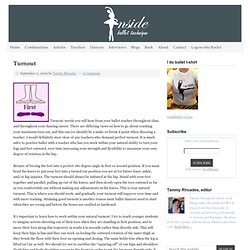
There are differing views on how to go about reaching your maximum turn out, and this can (or should) be a make or break it point when choosing a teacher. I would definitely steer clear of any teachers who demand perfect turnout. It is much safer to practice ballet with a teacher who has you work within your natural ability to turn your legs and feet outward, over time increasing your strength and flexibility to maximize your own degree of rotation in the hip.
Beware of forcing the feet into a perfect 180 degree angle in first or second position. If you must bend the knees to put your feet into a turned out position you are in for future knee, ankle, and/or hip injuries. It’s important to learn how to work within your natural turnout. Therabands are very useful devices for aiding in stretching and strengthening your whole body. The “Triad”: Are You at Risk? - Inside Ballet Technique. Whenever you think about nutrition in the United States, chances are you wonder why Americans consume so much food.

When you read the government’s 2010 statistics, which show that one in every three Americans is obese, the seriousness of the problem is quite obvious.1 Dancers are generally not affected by this problem because of the frequency and intensity of the mere act of dancing. From a young age, you have studied and learned the details of form and technique – you’ve slowly developed a unique, personal style that helps you express your deepest feelings and emotions. A dancer’s body curls, lengthens and spins creating an illusion, becoming art. That artistic instrument that is your body requires certain amounts of fuel, in the form of food that will be burned while taking classes, rehearsing and performing. “Some dancers aren’t aware of the fact that they’re not eating an adequate amount yet others do it consciously because of fear of gaining weight.” Hector Lozada. Effective Use of Turnout: Biomechanical, Neuromuscular, and Behavioral Considerations - By Gayanne Grossman, Ed.M., P.T., Donna Krasnow, M.S., and Thomas M. Welsh, Ph.D.
Understanding Turnout: Anatomical Tips to Success. I have created a couple of posts about turnout, but today, we are going to take a trip deeeep into anatomy class, Magic School Bus Style.
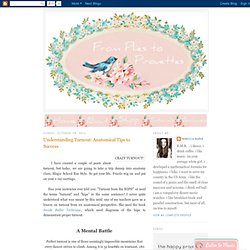
So get your Ms. Frizzle wig on and put on your x-ray earrings. Has your instructor ever told you: "Turnout from the HIPS! " or used the terms "turnout" and "hips" in the same sentence? I never quite understood what was meant by this until one of my teachers gave us a lesson on turnout from an anatomical perspective. A Mental Battle Perfect turnout is one of those seemingly impossible mountains that every dancer strives to climb. Now, let's just stop for a moment and think about why we dance. [Tweet this] Now that the guilt trip/crying bout/contemplation of life is over, let us begin today's lesson in anatomy. Bones The first thing to understand is that some people are born with hips easier to turn out. Ligaments. The Anatomy of Turnout.
Recently I have been thinking a LOT about turnout- who doesn't?
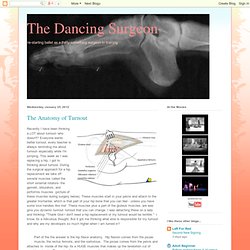
Everyone wants better turnout, every teacher is always reminding me about turnout- especially while I'm jumping. This week as I was replacing a hip, I got to thinking about turnout. During the surgical approach for a hip replacement we take off several muscles called the short external rotators- the gemelli, obturators, and piriformis muscles (picture of these muscles during surgery below). These muscles start in your pelvis and attach to the greater trochanter, which is that part of your hip bone that you can feel - unless you have some love handles like me! Turnout - Inside Ballet Technique. Pointe magazine – Ballet at its Best. Practical ways to improve turnout, extension, balance and jumps.

Part of what makes the spectacle of ballet so astonishing is the way dancers’ bodies seem to defy the laws of physics. To the average onlooker, a ballerina can effortlessly lift her leg to her ear while balancing on her toes; she can soar so high it looks like she can fly. But in accomplishing these seemingly magical feats, there’s actually little magic involved. Instead, they take a whole lot of hard work. Even the most talented dancers aren’t born with perfect ballet bodies. Tackle Your TurnoutHaving a narrow range of turnout affects everything from your first plié to the last grand jeté, since every movement in ballet starts with the outward rotation of the legs. Tips for Turnout - Achieving Your Ultimate Range. It seems like the flavour of the month in the clinic this month is turnout.
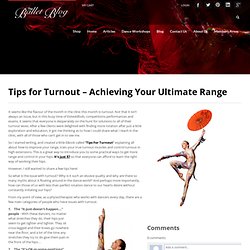
Not that it isn’t always an issue, but in this busy time of Eisteddfods, competitions performances and exams, it seems that everyone is desperately on the hunt for solutions to all of their turnout woes. After a few clients were delighted with finding more rotation after just a little exploration and education, it got me thinking as to how I could share what I teach in the clinic, with all of those who can’t get in to see me. So I started writing, and created a little EBook called “Tips For Turnout” explaining all about how to improve your range, train your true turnout muscles and control turnout in high extensions.
This is a great way to introduce you to some practical ways to get more range and control in your hips. It’s just $7 so that everyone can afford to learn the right way of working their hips. However, I still wanted to share a few tips here! So what is the issue with turnout? The Truth Behind the Ballet Body. Ballet Technique - Improve Ballet Technique. How to Stretch Your Hip Flexor Muscles for Ballet Dancers - Woman. The Truth About Turnout. American Ballet Theatre - Ballet Dictionary. Pointe magazine – Ballet at its Best. Ballet naturally creates strong legs.
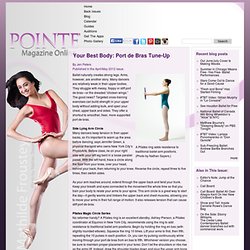
Arms, however, are another story. Many dancers are relatively weak in their upper bodies. They struggle with messy, floppy or stiff port de bras—or the dreaded “chicken wings.” The good news? Targeted cross-training exercises can build strength in your upper body without adding bulk, and open your chest, upper back and sides. As your arm reaches around, extend through the upper back and twist your trunk. Many dancers have loose shoulder joints but tight chests, creating dangerous joint imbalances that leave them susceptible to injury. Resistance On-The-GoThera-Bands are many dancers’ go-to, portable resistance tools. To strengthen the second position port de bras, Green has dancers wrap a semi-light band behind their back and hold the ends. Practiced regularly, these exercises will awaken integral stabilizing muscles and help you eliminate noodley, weak arms.
A Smarter Flip-FlopSandal season is nearly here. Understanding True Turnout In Dance.